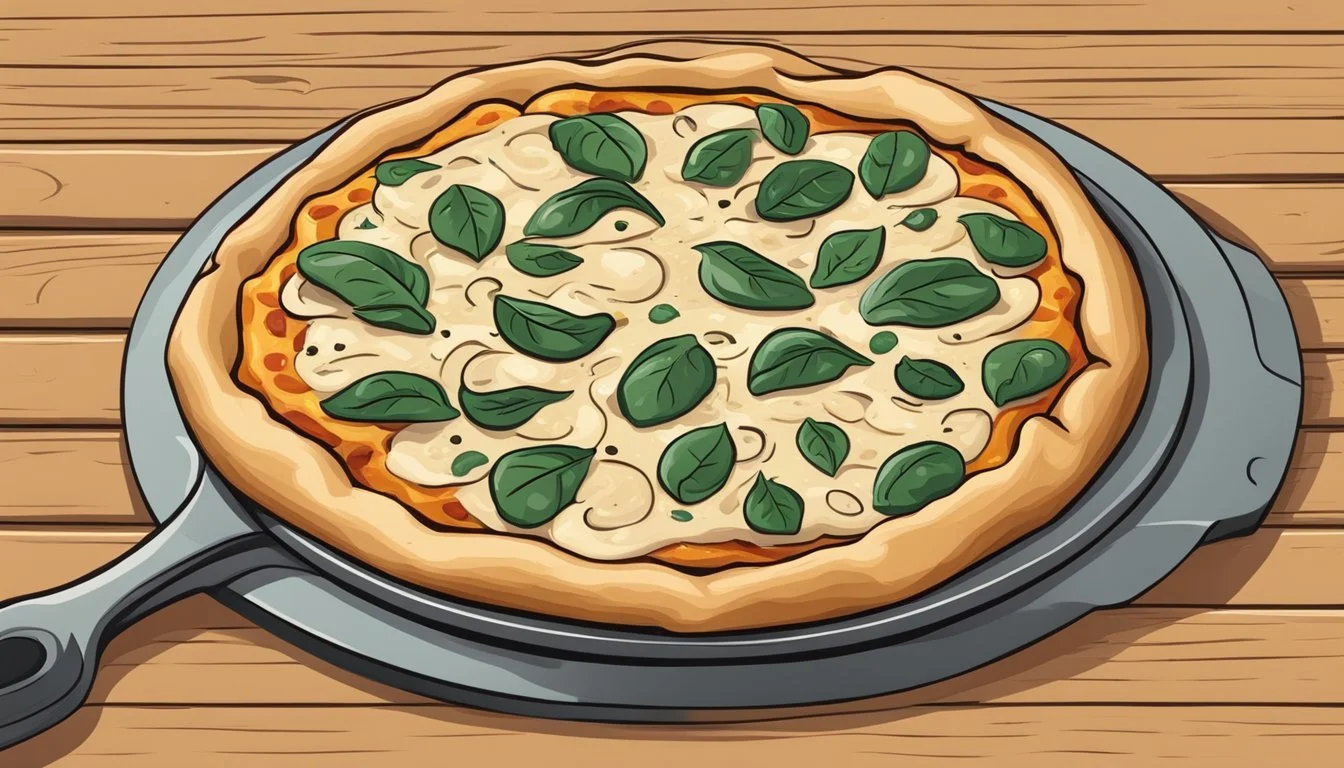Is Chicken Spinach Alfredo Pizza Vegan?
Debunking Common Food Myths
A traditional chicken spinach Alfredo pizza is a rich dish that features a creamy Alfredo sauce base, cooked chicken, and fresh spinach (What wine goes well with spinach?) atop a pizza crust. This combination of ingredients, particularly the Alfredo sauce made with dairy products and the chicken, categorizes the classic recipe as non-vegan. The core components of this type of pizza are animal-derived and thus not suitable for those following a plant-based lifestyle.
However, with the rise of veganism, there are now numerous adaptations of the original recipe that cater to vegan dietary preferences. These versions substitute the conventional ingredients with plant-based alternatives. The chicken is replaced with vegan meat substitutes or seasoned tofu, while the Alfredo sauce is reimagined using non-dairy alternatives like cashews or non-dairy milk, thickened with ingredients such as flour or nutritional yeast to mimic the rich, creamy texture.
When assessing if a chicken spinach Alfredo pizza is vegan, one must look closely at the ingredient list. Any pizza claiming to be vegan should solely consist of plant-based ingredients, ensuring no animal products are used throughout the preparation process. The availability of vegan cheeses and meat alternatives enables the creation of a pizza that replicates the flavors of the classic recipe while aligning with vegan principles.
Understanding Veganism
Analyzing the crux of veganism offers insights into its dietary framework, health implications, and the variety of available plant-derived alternatives to traditional animal-based ingredients.
Definition and Principles
Veganism is a dietary and lifestyle choice that excludes all animal products and by-products. It is rooted in the ethical principle of minimizing harm to animals, and extends beyond diet to avoid animal exploitation in all forms including clothing, cosmetics, and more. Plant-based foods form the core of a vegan diet, with a strict avoidance of meat, dairy, eggs, and honey.
Health Benefits and Nutrients
Adopting a vegan diet can offer several health benefits, including but not limited to lower risks of heart disease, hypertension, type 2 diabetes, and certain types of cancer. Vegans often experience a diet high in dietary fiber, vitamins, and phytonutrients, with typically lower levels of saturated fats and cholesterol. Critical nutrients that require attention in a vegan diet include protein, iron, calcium, vitamins B12 and D, omega-3 fatty acids, and zinc. A well-planned vegan diet that includes a variety of whole foods can meet nutritional needs. However, some may choose to supplement specific nutrients to ensure adequate intake.
Nutrients of Consideration in a Vegan Diet:
Nutrient Plant-Based Sources Protein Tofu, legumes, nuts, seeds, grains Iron Legumes, dark leafy greens, dried fruit Calcium Fortified non-dairy milk, tofu, kale Vitamin B12 Fortified foods, supplements Omega-3 Fatty Acids Flaxseeds, chia seeds, walnuts
Common Vegan Substitutes
Vegans replace traditional dairy and meat products with alternatives that mirror the taste, texture, and nutritional profile without animal exploitation. Vegan cheese and vegan parmesan can be found made from nuts, soy, and other plant materials. Vegan butter is a non-dairy alternative usually made from plant oils. Vegan chicken, made from soy or wheat gluten, provides a meaty texture and protein. Nutritional yeast offers a cheesy flavor and is a source of B vitamins. Non-dairy milk—such as almond, soy, or oat milk—is used instead of cow's milk. For dishes like chicken spinach alfredo pizza, a vegan alfredo sauce can be made using ingredients like cashews or tofu to mimic the creamy texture and rich taste of traditional alfredo sauce.
Components of Chicken Spinach Alfredo Pizza
When crafting a Chicken Spinach Alfredo Pizza, one typically encounters a variety of components ranging from a rich, creamy sauce to a selection of cheeses and toppings. Understanding these components can guide individuals in preparing this dish, whether from a traditional or adapted recipe.
Traditional Ingredients Overview
Dough and Crust:
The foundation is often a hand-stretched or rolled pizza dough consisting of all-purpose flour, yeast, salt, sugar, olive oil, and water. A pizza stone or baking sheet lined with parchment paper can be used for baking. The dough generally requires a pre-bake at high temperatures.Alfredo Sauce:
A homemade Alfredo sauce forms the creamy base, made with butter, heavy cream, and Parmesan cheese. Seasoned with sea salt, black pepper, and sometimes garlic powder or fresh garlic, it is simmered until thickened.Toppings:
Grilled or sautéed chicken cut into bite-size pieces is the protein of choice. Spinach is often briefly cooked or wilted to retain its color and texture. Mozzarella cheese is then sprinkled atop for meltiness.
Dough and Crust Alternatives
For those seeking alternatives, gluten-free or whole wheat flours can be substitutes for traditional all-purpose flour. It's crucial to adjust other ingredients like water and oil accordingly to achieve the desired dough texture. A pizza pan can also be utilized to ensure even cooking.
Homemade Alfredo Sauce
Creating a roux with butter and flour can elevate the Alfredo sauce's texture, allowing it to thicken more efficiently when mixed with heavy cream or almond milk for a lighter version. This homemade sauce is gently simmered in a medium saucepan, with added Parmesan cheese folded in until smooth, followed by seasoning with salt and black pepper to taste.
Adapting the Recipe for Vegans
To craft a Vegan Chicken Spinach Alfredo Pizza, careful selection of plant-based substitutes is crucial. Vegan alternatives ensure the classic flavor is retained while adhering to vegan dietary standards.
Vegan Substitutes for Chicken
Vegan chicken alfredo (What wine goes well with chicken alfredo?) pizza relies on replacing traditional chicken with plant-based options. Vegan chicken strips made from soy or vital wheat gluten can serve as ideal substitutes. For a whole-food alternative, one can opt for grilled tofu (What wine goes well with grilled tofu?) , seasoned with herbs like oregano and thyme to enhance the taste. These substitutes not only maintain the texture but also significantly reduce saturated fat and sodium levels compared to traditional chicken.
Vegan Cheese and Sauce Options
A rich vegan alfredo sauce forms the base of the pizza. A common recipe involves creating a base with non-dairy milk and thickening it with cornstarch or flour. Nutritional yeast and vegan parmesan can add depth to the flavor, emulating the cheesiness without dairy. Vegan cheese, especially those that melt well, can be sprinkled on top. These cheese alternatives are typically lower in saturated fat compared to dairy cheeses while remaining creamy and delicious.
Seasonings and Flavor Add-ins
The seasonings in a vegan chicken spinach alfredo pizza enhance the overall flavor profile. Garlic cloves are foundational, offering an aromatic kick. Lemon juice can provide a bright, tangy note, balancing the richness of the alfredo sauce. Red pepper flakes introduce a subtle heat that complements the mellow vegan cheese. Other flavorful add-ins include artichoke hearts, which introduce a pleasant texture and are a heart-healthy choice.
Nutritional Information
Chicken spinach Alfredo pizza, as traditionally prepared with chicken, cheeses, Alfredo sauce, and dough, is not vegan due to the presence of animal-based ingredients. The nutritional values of a typical chicken spinach Alfredo pizza per serving can be quite dense, given the richness of Alfredo sauce and the cheese used. Here's a breakdown of the nutritional content one might expect in a standard serving:
Calories: Traditional chicken spinach Alfredo pizzas are calorically dense, with a single slice (1/8 of a whole pizza) averaging between 300 to 400 calories.
Saturated Fat: Pizzas, especially those with creamy sauces (What wine goes well with creamy sauces?) and cheese, are high in saturated fats. A slice could contribute to 5-8 grams of saturated fat.
Sugar: While not a sweet dish, pizzas may contain sugars in the sauce and dough. Each slice may account for about 1-3 grams of sugar.
Fiber: Whole-wheat pizzas offer more fiber. A slice using white flour might offer around 1-2 grams of fiber, while one with whole grain crust may have slightly more.
Sodium: Cheese and store-bought Alfredo sauces contribute to the high sodium content. A slice may contain nearly 500-700 mg of sodium.
Iron: While not a prominent nutrient in pizza, chicken and spinach can contribute minor amounts of iron.
Here's a table for quick reference (estimates per slice):
Nutrient Amount Calories 300-400 kcal Saturated Fat 5-8 g Sugar 1-3 g Fiber 1-2 g Sodium 500-700 mg Iron Varies
For consumers seeking vegan options, it is worth noting that nutritional content will differ significantly when substitutes like vegan cheeses and plant-based chicken alternatives are used, potentially altering the calorie and macronutrient profile.
Cooking and Preparation Guidelines
The cooking and preparation of chicken spinach alfredo pizza require precise techniques to ensure the best texture and flavor. The guidelines below cover baking methods, presentation advice, and storage tips for leftovers.
Baking Techniques
For an authentic texture, it's paramount that the oven is preheated properly, often to a high temperature such as 475°F. The pizza dough should be evenly spread on a baking sheet lined with parchment paper to prevent sticking. One should bake the pizza until the crust is golden brown and the toppings are properly heated through. Vegan substitutes such as non-dairy cheese and vegan "chicken" should also reach a golden hue, resembling their traditional counterparts.
Serving and Presentation
Once baked, the pizza should be served immediately for the best taste and texture. Toppings like arugula or kale can be added fresh after baking for a crisp contrast to the warm, creamy base. Slice the pizza with a pizza cutter or a sharp knife to ensure clean cuts without displacing the toppings.
Storing Leftovers
To maintain freshness, store leftover pizza in an airtight container and refrigerate. The leftovers should be consumed within 2-3 days. To reheat, a conventional oven or toaster oven can be used to preserve the pizza's desirable crispy crust. Avoid microwaving if possible, as it can result in a soggy texture.
Recipes and Variations
When exploring the realm of alfredo pizzas, one finds both classic and vegan variations suitable for different dietary preferences. Alfredo pizza typically features a creamy white sauce and tender chicken, whereas vegan versions substitute plant-based components for a compassionate twist on the traditional slice.
Classic Chicken Alfredo Pizza Recipe
Traditional chicken alfredo pizza combines savory chicken breasts (What wine goes well with chicken breast?) with a rich, creamy alfredo sauce atop a delightful crust. The white pizza base provides a sumptuous canvas for layers of mozzarella, garlic, and sometimes a touch of basil to enhance the flavor profile. Ingredients and techniques may vary, but a homemade pizza recipe often involves pre-baking a crust, topping it with alfredo sauce and cooked chicken, and finishing with a swift bake until the cheese is bubbly and golden.
Ingredients:
1 pre-made pizza crust or homemade pizza dough
2 cups mozzarella cheese, shredded
1 cup alfredo sauce (store-bought or homemade)
1 cup cooked chicken breasts, diced or shredded
1 tablespoon olive oil
Optional: Fresh basil leaves for garnish
Instructions:
Preheat the oven as directed by the pizza crust recipe or packaging.
Spread the alfredo sauce evenly over the crust.
Top with cooked chicken and sprinkle mozzarella cheese.
Bake until the cheese melts and the crust turns golden brown.
Garnish with basil before serving on pizza night.
Vegan Chicken Alfredo Pizza Recipe
For those seeking a plant-based alternative, a vegan chicken alfredo pizza can be just as satisfying. It often includes a homemade vegan alfredo sauce made from non-dairy milk and vegan butter, enhanced with nutritional yeast for a cheesy flavor without the cheese. Vegan chicken products provide protein and texture akin to the real thing. A garnish of fresh tomato or spinach adds a nutritious boost to this healthy pizza recipe.
Ingredients:
1 pre-made vegan pizza crust or homemade crust
1 cup vegan alfredo sauce (with non-dairy milk and vegan butter)
1 cup vegan chicken, cooked and seasoned
1 cup vegan cheese, shredded
Optional: Spinach or tomato slices for added nutrition
Instructions:
Preheat the oven according to the crust's requirements.
Spread the vegan alfredo sauce on the crust.
Distribute the vegan chicken and sprinkle with vegan cheese.
Bake until the vegan cheese is melted and edges are crispy.
Add fresh spinach or tomato slices if desired, then serve.
Both recipes offer a twist on the classic alfredo pizza to accommodate a variety of tastes and dietary needs, ensuring everyone can enjoy a slice on pizza night.
Culinary Techniques
When preparing a chicken spinach Alfredo pizza, certain culinary techniques are crucial for achieving the desired flavors and textures. From grilling the chicken to creating a perfect pizza dough, these skills are integral to the cooking process.
How to Grill Chicken
Grilling chicken for pizza topping involves marinating and cooking the chicken breasts to perfection. For a flavorful result, one can marinate the chicken breasts in a mixture of olive oil, salt, garlic powder, and dried thyme. After marinating, the chicken should be grilled over medium heat until it obtains a nice char and internal temperature of 165°F (74°C). It's important to let the grilled chicken rest before slicing it to retain moisture. If one prefers, rotisserie chicken can be an alternative for a quicker option with a similar taste profile.
Creating Homemade Dough
To craft homemade pizza dough, one starts by mixing all-purpose flour with yeast, salt, and water. This dough comes together after a series of mixing, kneading, and rising, generally taking about an hour to proof before it's ready to be shaped. For an ideal pizza base, the following table illustrates the basic steps to create a simple yet effective dough:
Activate the Yeast: Mix warm water with yeast and a pinch of sugar until frothy—a signal that the yeast is alive and active.
Combine Ingredients: In a large bowl, whisk together all-purpose flour and salt. Add the yeast mixture to the flour.
Knead the Dough: Knead on a floured surface until smooth and elastic, about 10 minutes, adding extra flour as needed.
Proof the Dough: Place the dough in a greased bowl, cover with a damp cloth, and let it double in size.
Shape the Dough: Punch down the risen dough and shape it into a ball. Roll out the dough to form a pizza crust before adding toppings.
These techniques form the foundation of a chicken spinach Alfredo pizza that is sure to be both tasty and satisfying.
Exploring Dietary Needs
When customizing a chicken spinach Alfredo pizza to meet specific dietary needs, customers often consider gluten-free options and calorie-conscious toppings. Attention to the choice of flour and toppings is crucial for maintaining both dietary restrictions and nutritional balance.
Gluten-Free Adjustments
Ingredients for a Gluten-Free Crust:
1 tsp xanthan gum (if not included in the flour blend)
¼ cup olive oil
Warm water as needed for the dough consistency
To accommodate a gluten-free diet, it is essential to substitute the traditional wheat-based crust with a gluten-free alternative. A mix of gluten-free all-purpose flour and xanthan gum can mimic the texture of a wheat crust. Gluten imposes dietary restrictions for individuals with celiac disease or gluten sensitivity; therefore, ensuring that all ingredients, especially the flour, are certified gluten-free is important.
Calorie-Conscious Toppings
Optimal Low-Calorie Toppings:
Veggies: Spinach, tomatoes, artichokes, (What wine goes well with artichokes?) bell peppers
Cheese: Reduced-fat or low-calorie shredded mozzarella cheese
Protein: Grilled chicken breast or plant-based substitutes
For those aiming to reduce caloric intake, attention to the toppings is crucial. Veggies add nutritional value and fiber while keeping the calorie count low. Reduced-fat shredded mozzarella cheese offers a way to enjoy the richness of cheese without excess calories. Choosing toppings wisely, such as lean proteins and an abundance of vegetables, can create a nutritious, balanced meal that aligns with calorie-conscious goals.









